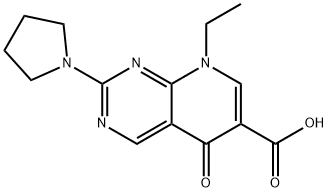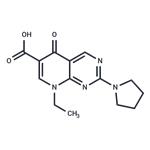Description
Piromidic acid is a quinolone antibiotic that is active against Gram-positive and Gram-negative bacteria including
S. aureus and
E. coli (MICs = 10 and 1 μg/ml, respectively). It inhibits growth of nalidixic acid-sensitive strains of
E. coli in an
in vitro model of bacterial cystitis when used at concentrations of 10 and 50 mg/L. Piromidic acid also has antimalarial properties and is active against chloroquine-sensitive and -resistant strains of
P. falciparum in vitro (IC
50s = 41.4 and 14.4 μg/ml, respectively) as well as against hepatic stages of
P. yoelii yoelii (IC
50 = 21.6 μg/ml).
Originator
Panacid, Dainippon, Japan ,1972
Uses
Antibacterial;Topoisomerase II inhibitor
Uses
Piromidic acid is a quinolone antibacterial.
Definition
ChEBI: Piromidic acid is a pyridopyrimidine that is 5-oxo-5,8-dihydropyrido[2,3-d]pyrimidine-6-carboxylic acid, substituted at position 2 by a pyrrolidin-1-yl group and at position 8 by an ethyl group. A synthetic antibacterial which is used for the treatment of urinary tract and intestinal infections. It has a role as an antibacterial drug and a DNA synthesis inhibitor. It is a quinolone antibiotic, a member of pyrrolidines, a tertiary amino compound, a monocarboxylic acid and a pyridopyrimidine.
Manufacturing Process
150 mg of 6-carboxy-5,8-dihydro-8-ethyl-2-methylthio-5-oxopyrido[2,3d]pyrimidine was added to 30 ml of absolute ethanol containing 1.1 g of dissolved pyrrolidine, and the mixture was reacted for 5 hours at 95°C in a sealed tube. The solvent was removed by distillation, and the residue was recrystallized from methanol-chloroform. There were obtained 111 mg of 6carboxy-5,8-dihydro-8-ethyl-5-oxo-2-pyrrolidino-pyrido[2,3-d]pyrimidine having a MP of 314° to 316°C.
The starting material is produced by reacting 6-amino-2-methylthiopyrimidine with ethoxymethylene malonic acid diethyl ester. That intermediate is thermally treated in diphenyl ether to give 6-ethoxycarbonyl-2-methylthio-5oxo-5,8-dihydro-pyrido[2,3-d]pyrimidine. The ethoxy group is hydrolyzed off with sodium hydroxide and one nitrogen is ethylated with diethyl sulfate to give the starting material. These are the same initial steps as used in the pipemidic acid syntheses earlier in this volume.
Therapeutic Function
Antibacterial (urinary)
Pharmaceutical Applications
A pyrimidopyrimidine derivative with a C7-pyrrolidinyl ring, allowing a slight increase in activities against Gram-positive cocci. Its main antibacterial activity is close to that of nalidixic acid and there have been reports of renal toxicity. It is available in only a few countries.
Safety Profile
Poison by subcutaneous and intravenous routes. Moderately toxic by skin contact and intraperitoneal routes. An antibacterial agent. When heated to decomposition it emits toxic fumes of NOx.


